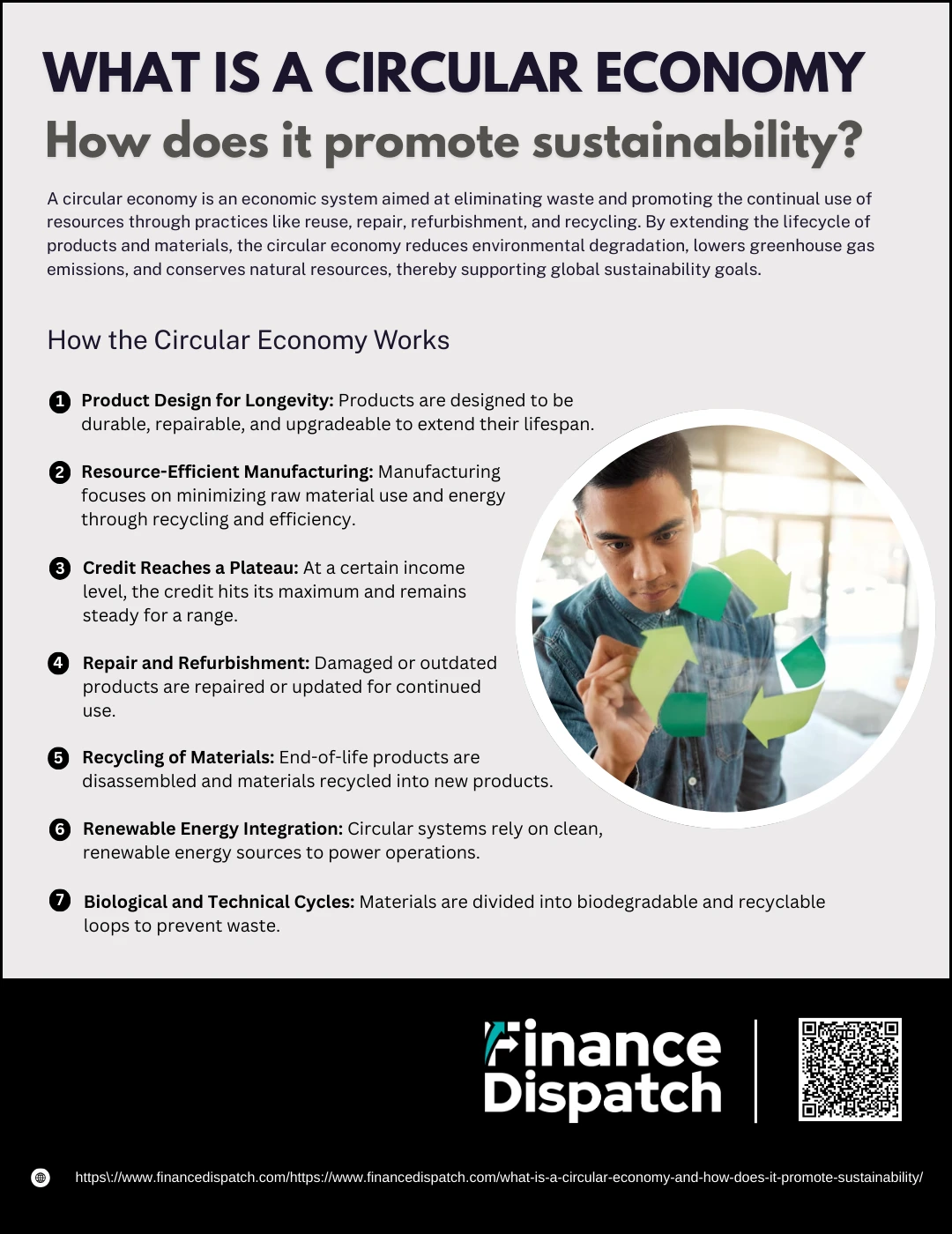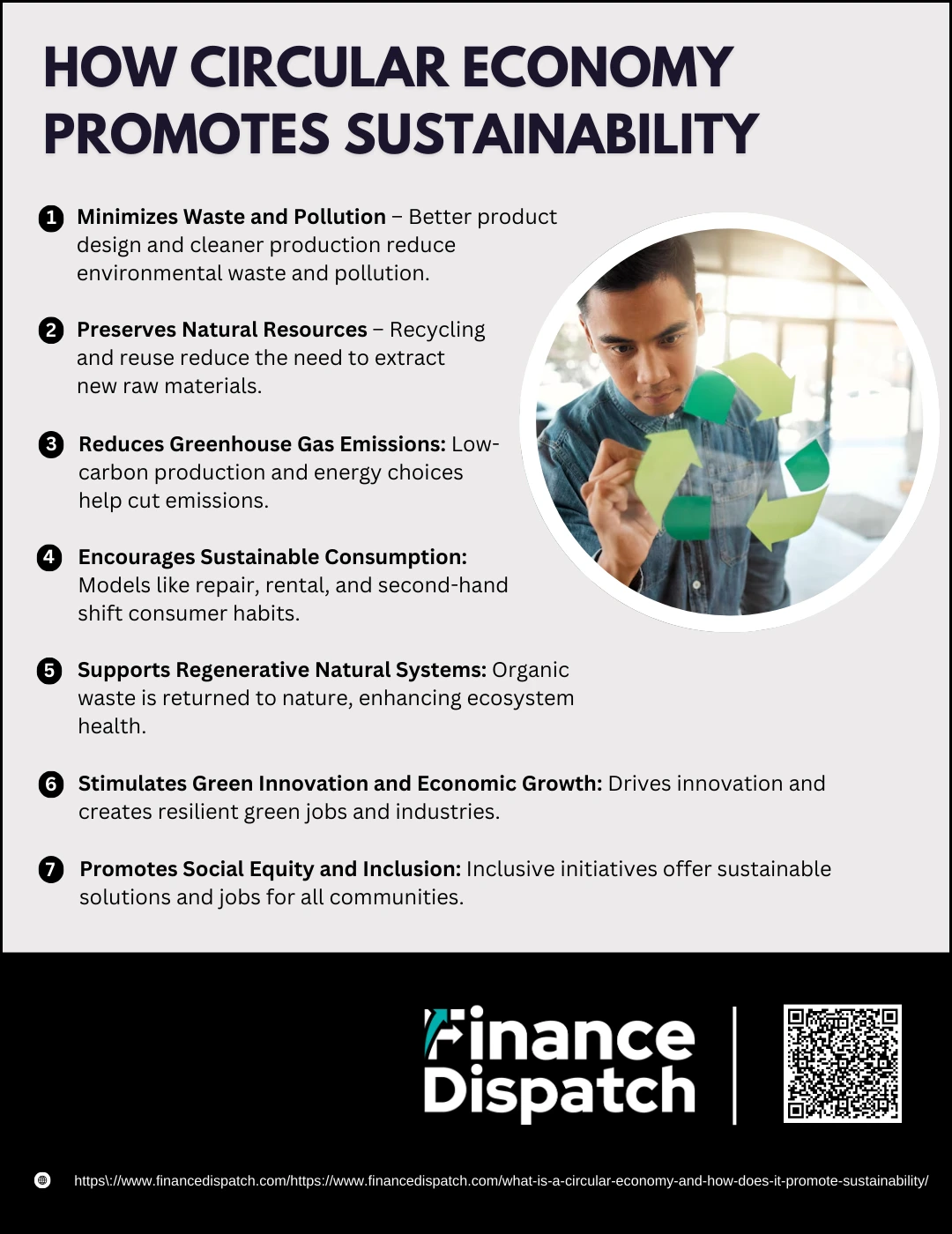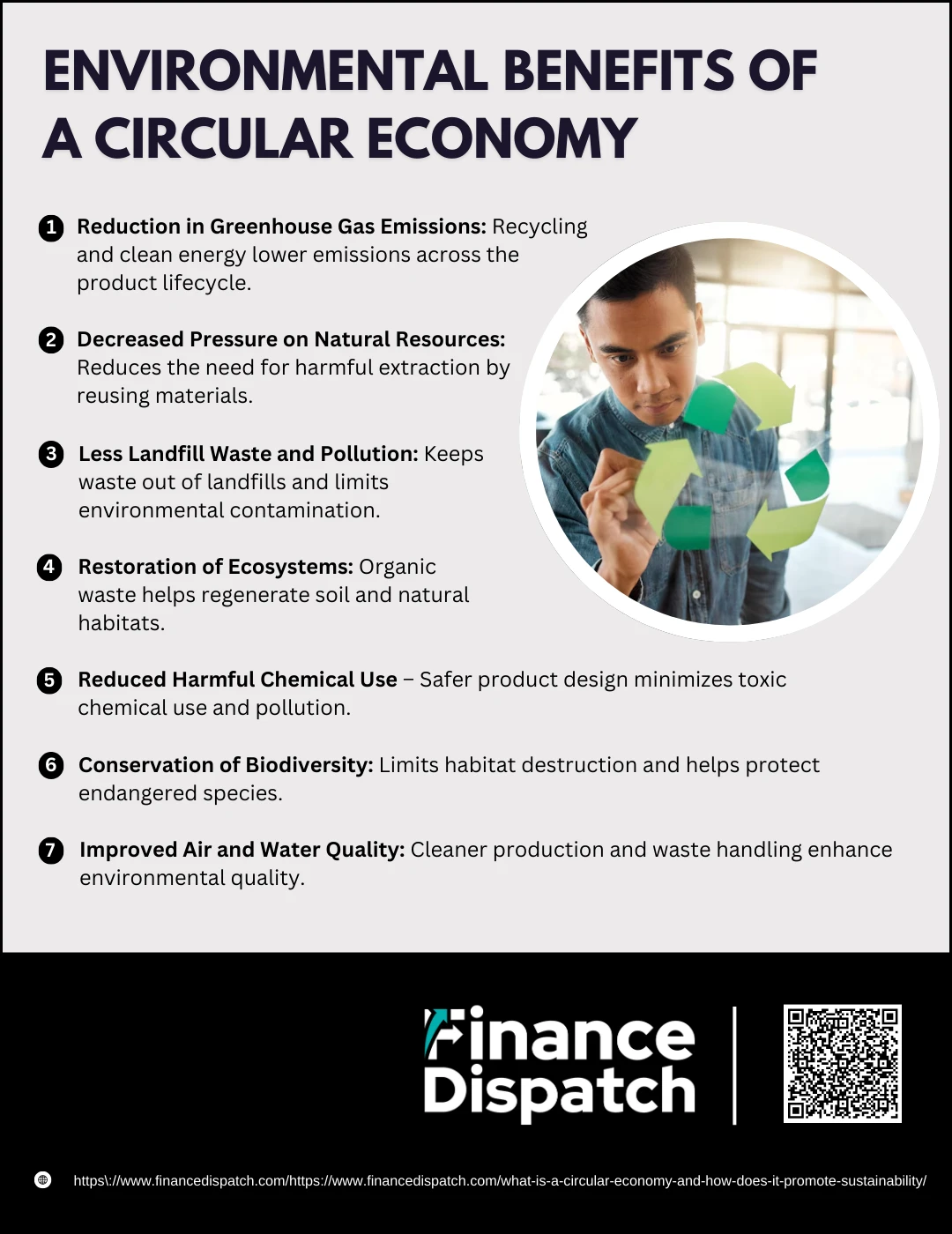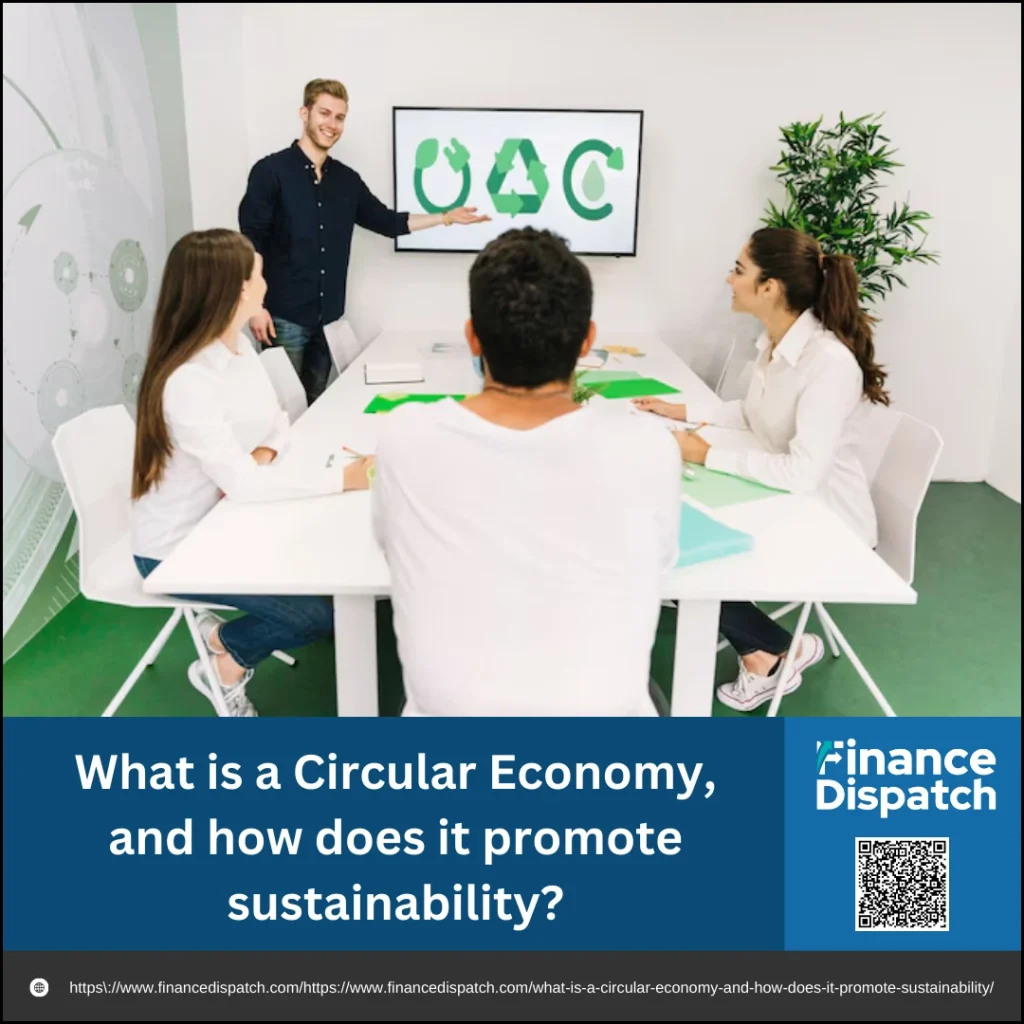In a world grappling with resource scarcity, climate change, and mounting waste, the traditional “take-make-dispose” economic model has proven increasingly unsustainable. This linear system encourages rapid consumption and short product lifespans, leading to environmental degradation and economic inefficiency. In contrast, the circular economy offers a transformative alternative—an approach that prioritizes resource efficiency, product longevity, and waste reduction through practices such as reuse, recycling, and design innovation. By mimicking nature’s regenerative cycles, the circular economy not only addresses environmental challenges but also supports long-term economic resilience and social well-being. Understanding this model is essential to building a future where sustainability is embedded in every stage of production and consumption.
What is a Circular Economy?
A circular economy is an economic model designed to keep products, materials, and resources in use for as long as possible by minimizing waste and maximizing value at every stage of the lifecycle. Unlike the traditional linear economy—which follows a one-way path of extraction, production, consumption, and disposal—the circular economy operates in closed loops. It emphasizes strategies like reusing, repairing, refurbishing, remanufacturing, and recycling, ensuring that materials re-enter the production cycle instead of becoming waste. This model encourages innovation in product design, business models, and consumption patterns, shifting the focus from ownership to access, and from disposal to regeneration. By doing so, it decouples economic growth from the depletion of finite resources and aligns industrial activity with environmental stewardship.
Core Principles of a Circular Economy
At the heart of a circular economy lies a set of guiding principles that redefine how we produce, consume, and manage resources. These principles aim to eliminate waste, extend the lifespan of products, and regenerate natural systems, all while fostering innovation and sustainable growth. By integrating these practices, economies can move away from the extractive, wasteful linear model and toward a restorative, efficient, and resilient system.
Key Principles:
- Design Out Waste and Pollution: Products are created with long-term use, recyclability, and minimal environmental impact in mind.
- Keep Products and Materials in Use: Materials are kept in circulation through reuse, repair, refurbishment, and remanufacturing.
- Prioritize Renewable Resources: Energy and raw materials come from renewable sources, reducing dependence on finite inputs.
- Extend Product Life Cycles: Items are made to last longer through durable design and easy maintenance.
- Encourage Reuse and Sharing Models: Emphasis is placed on models like leasing, renting, or sharing to maximize resource use.
- Valorize Waste: When reuse or recycling isn’t possible, waste is used to recover energy or valuable materials.
- Apply Systems Thinking: Understand and design products as part of a larger interconnected system with long-term environmental and economic impacts.
- Promote Eco-Design: Products are designed considering their entire lifecycle, aiming to reduce ecological footprints from production to disposal.
- Enable Regenerative Practices: Economic activities contribute positively to natural ecosystems, such as improving soil health or restoring biodiversity.
 How the Circular Economy Works
How the Circular Economy Works
The circular economy is a transformative model that reimagines how we design, produce, and consume goods. Unlike the traditional linear economy that ends in disposal, the circular economy aims to close the loop by keeping resources in use and regenerating natural systems. This approach ensures that economic activity decouples from resource depletion and environmental degradation. Below is a breakdown of how the circular economy operates in practice.
1. Product Design for Longevity
Circular products begin with smart design. Manufacturers focus on creating items that are long-lasting, easy to repair, modular, and upgradeable. For example, furniture that can be disassembled and rebuilt, or smartphones with replaceable parts, are designed to reduce waste and extend product life. This reduces the frequency of replacements and limits the use of raw materials.
2. Resource-Efficient Manufacturing
Circular manufacturing processes prioritize efficiency and sustainability. Factories use fewer raw materials and minimize energy consumption by integrating recycled or renewable inputs. Waste from one process is reused as input for another, creating industrial symbiosis. This results in lower production costs, reduced emissions, and decreased dependence on virgin resources.
3. Reuse and Redistribution
Products that are no longer needed by one user can be redistributed for continued use. This is commonly seen in second-hand markets, sharing platforms (like car or tool-sharing), and rental services. By keeping items in circulation longer, this strategy reduces the demand for new products and conserves resources.
4. Repair and Refurbishment
Rather than discarding broken or outdated items, the circular economy emphasizes repair and refurbishment. This involves restoring products to working condition or upgrading them for new users. Businesses that offer repair services or sell refurbished electronics play a key role in making sustainability accessible and practical.
5. Recycling of Materials
When products reach the end of their usable life, they are disassembled, and their materials—such as metals, plastics, and glass—are recycled. These materials are then reprocessed into raw inputs for new products. Effective recycling systems reduce landfill waste and limit the need for extracting new resources.
6. Renewable Energy Integration
Circular systems are powered by renewable energy sources like solar, wind, and hydro. Transitioning away from fossil fuels is critical to achieving low-carbon production and distribution. Renewable energy supports the energy demands of circular manufacturing and recycling without adding to environmental harm.
7. Biological and Technical Cycles
The circular economy distinguishes between two types of materials:
- Biological materials (e.g., food waste, natural fibers) are biodegradable and can safely return to the environment through composting or anaerobic digestion.
- Technical materials (e.g., metals, plastics, synthetic chemicals) are reused, repaired, or recycled indefinitely.
Managing these cycles properly ensures that materials never become waste and instead flow continuously through the economy.
 How Circular Economy Promotes Sustainability
How Circular Economy Promotes Sustainability
The circular economy plays a vital role in promoting sustainability by fundamentally rethinking how we use resources, produce goods, and manage waste. It shifts away from the extractive, throwaway culture of the linear economy and instead fosters a system that prioritizes efficiency, regeneration, and long-term value. By doing so, it not only reduces environmental harm but also supports economic resilience and social equity. Here’s how the circular economy contributes to a more sustainable future:
1. Minimizes Waste and Pollution
By designing products for durability, repairability, and recyclability, the circular economy reduces the amount of waste that ends up in landfills and the environment. Pollution from manufacturing and disposal is also significantly lowered through cleaner production methods and responsible material use.
2. Preserves Natural Resources
Instead of continuously extracting raw materials, the circular model emphasizes reuse and recycling, thereby reducing the pressure on finite natural resources like minerals, forests, and freshwater. This approach helps maintain ecological balance and protects biodiversity.
3. Reduces Greenhouse Gas Emissions
Circular practices such as recycling, renewable energy use, and resource-efficient production lead to lower carbon emissions. These reductions are essential for combating climate change and aligning with global targets like those outlined in the Paris Agreement.
4. Encourages Sustainable Consumption
By promoting product-as-a-service models, second-hand markets, and repair services, the circular economy shifts consumer behavior toward more thoughtful and responsible consumption. This reduces overproduction and shortens supply chains, making them more sustainable.
5. Supports Regenerative Natural Systems
Biodegradable waste in a circular system can be composted or converted into bioenergy, returning nutrients to the soil and enhancing ecosystem health. This mimics nature’s own cycles, where nothing is wasted and everything serves a purpose.
6. Stimulates Green Innovation and Economic Growth
The need to keep products and materials in use drives innovation in design, business models, and technology. This results in new market opportunities, job creation, and a more resilient economy that grows without exhausting the planet.
7. Promotes Social Equity and Inclusion
Circular economy initiatives—such as community repair workshops, recycling cooperatives, and local food systems—often create inclusive job opportunities and improve access to sustainable goods and services for underserved populations.
 Environmental Benefits of a Circular Economy
Environmental Benefits of a Circular Economy
The circular economy is not just an economic innovation—it is an environmental necessity. As the planet faces unprecedented challenges such as climate change, biodiversity loss, and pollution, the need for a more sustainable model of growth has become urgent. The circular economy addresses these issues by fundamentally rethinking how resources are used, ensuring that products and materials are kept in circulation for as long as possible. This shift from a linear to a circular model significantly reduces environmental harm while actively restoring and regenerating natural ecosystems.
1. Reduction in Greenhouse Gas Emissions
By emphasizing renewable energy, efficient resource use, and low-carbon manufacturing, the circular economy helps reduce emissions at every stage of a product’s lifecycle. For example, recycling materials like aluminum or steel emits far fewer greenhouse gases than extracting and processing raw materials. This directly contributes to mitigating global warming and helps countries meet international climate targets such as the Paris Agreement.
2. Decreased Pressure on Natural Resources
Circular practices reduce the constant demand for raw material extraction by encouraging reuse, recycling, and remanufacturing. This eases the environmental degradation caused by mining, logging, and drilling—protecting forests, rivers, soil, and other ecosystems from overexploitation and collapse.
3. Less Landfill Waste and Pollution
The circular economy drastically reduces the volume of waste sent to landfills and incinerators. Instead of becoming pollutants, end-of-life products are repurposed or recycled into new inputs. This not only reduces toxic leachate and methane emissions from landfills but also prevents waste from polluting oceans, rivers, and rural landscapes.
4. Restoration of Ecosystems
Biodegradable materials in a circular economy can return safely to the earth through composting, enriching soil fertility and supporting plant growth. Agricultural and food waste, when properly managed, can be converted into bioenergy or used to regenerate farmland, contributing to healthier and more resilient ecosystems.
5. Reduced Harmful Chemical Use
Circular design encourages the elimination of toxic and non-recyclable substances in products. This minimizes exposure to harmful chemicals during manufacturing, use, and disposal, reducing the risk of air and water contamination and promoting a safer environment for humans and wildlife alike.
6. Conservation of Biodiversity
By reducing the need for raw material extraction, land conversion, and pollution, circular models help preserve wildlife habitats and protect endangered species. Sustainable forestry, fisheries, and agriculture within circular systems prevent the loss of biodiversity caused by habitat destruction and ecosystem imbalance.
7. Improved Air and Water Quality
With less waste burning, cleaner manufacturing, and reduced runoff of industrial pollutants, circular systems lead to cleaner air and water. For instance, using natural dyes in textiles and bio-based cleaning agents cuts chemical runoff, improving water quality in nearby rivers and oceans.
Economic and Social Benefits
The circular economy does more than protect the environment—it also generates substantial economic and social value. By rethinking how resources are used and managed, this model drives innovation, creates jobs, reduces costs, and fosters inclusive growth. Circular systems support resilient local economies, empower communities, and help build a more equitable and sustainable future for all. Below are some of the key economic and social benefits offered by the transition to a circular economy:
Economic Benefits:
1. Cost Savings for Businesses
Companies save money by using fewer raw materials, optimizing production processes, and reducing waste management costs.
2. New Revenue Streams
Businesses can generate income through repair services, product leasing, resale of refurbished items, and recycled material markets.
3. Innovation and Competitiveness
The circular model encourages innovation in product design, supply chains, and business models, helping firms stay competitive in a sustainability-driven market.
4. Increased Resource Security
Recycling and reusing materials reduces dependence on volatile global markets for raw materials, improving supply chain resilience.
5. Support for Small and Medium Enterprises (SMEs)
Local repair shops, recyclers, and sustainable product designers benefit from the demand for circular services and goods.
Social Benefits:
1. Job Creation Across Sectors
Repair, refurbishment, recycling, and remanufacturing industries create employment opportunities in both skilled and unskilled sectors.
2. Improved Product Accessibility
Durable and reused products are often more affordable, giving consumers better access to quality goods.
3. Community Empowerment
Local initiatives like repair cafés and sharing networks promote social cohesion and community engagement.
4. Better Public Health
Cleaner production processes and reduced pollution lead to improved air and water quality, benefiting public health.
5. Equitable Development
Circular economy initiatives can be designed to include marginalized groups, offering training, income opportunities, and long-term social mobility.
Circular Economy in Action: Real-World Examples
The circular economy is not just a theory—it is already being implemented across industries and regions through innovative projects and business models. From sustainable fashion and electronics to waste management and food systems, real-world examples show how circular practices can reduce environmental impact, generate economic value, and improve social outcomes. These initiatives prove that transitioning to circular systems is both practical and scalable. The table below highlights key examples from different sectors around the world:
| Sector | Example | Circular Practice | Impact |
| Fashion | Patagonia Worn Wear | Repairing and reselling used clothing | Extends product life, reduces textile waste |
| Electronics | Apple’s Daisy Robot | Automated disassembly for material recovery | Recovers valuable metals, reduces e-waste |
| Retail Packaging | Loop by TerraCycle | Reusable containers for household products | Cuts single-use plastic, promotes reuse |
| Construction | Biobased Timber Buildings (Europe) | Reuse of timber and regenerative materials | Reduces emissions, promotes biodegradable materials |
| Food | Japan’s Food Recycling Law | Conversion of food waste to animal feed and fertilizer | Decreases organic waste, supports sustainable farming |
| Local Government | San Francisco Zero Waste Program | City-wide recycling and composting | Achieved over 80% waste diversion from landfills |
| Textiles | H&M Garment Collection Program | Take-back and recycling of used clothes | Encourages responsible consumption and production |
| Community Action | Repair Cafés (Global) | Free public events for repairing electronics and household items | Empowers communities, reduces consumer waste |
Challenges in Transitioning to Circular Models
While the circular economy presents a promising path toward sustainability, shifting from traditional linear systems to circular models is not without its obstacles. The transition requires major changes in infrastructure, business practices, consumer behavior, and regulatory frameworks. Despite its long-term benefits, many organizations and governments face short-term barriers that hinder progress. Understanding these challenges is crucial for developing strategies that can accelerate the adoption of circular practices.
1. Lack of Awareness and Education
Many businesses and consumers are unfamiliar with circular economy concepts, limiting adoption due to a lack of understanding or perceived complexity.
2. High Initial Costs
Upfront investments in redesigning products, updating technology, and building recycling infrastructure can be a major financial burden, especially for small enterprises.
3. Inadequate Infrastructure
Most regions lack the collection, sorting, and processing systems needed to support large-scale reuse, repair, and recycling efforts.
4. Limited Access to Finance
Circular startups and projects often struggle to secure funding, as investors prioritize short-term returns over long-term sustainability goals.
5. Policy and Regulatory Gaps
Existing policies tend to favor linear production models, and there is often a lack of incentives or clear regulations supporting circular innovations.
6. Consumer Habits and Cultural Norms
Shifting consumer preferences from ownership to access, or from new to refurbished products, requires significant behavioral change.
7. Supply Chain Complexity
Implementing circular practices across global supply chains involves coordination across multiple tiers, which can be difficult to manage and track.
8. Measurement and Data Limitations
Measuring circularity and its environmental and economic impact is still evolving, making it challenging for organizations to track progress and make informed decisions.
Circular Economy and the Global SDGs
The circular economy plays a pivotal role in advancing the United Nations Sustainable Development Goals (SDGs), offering a practical framework to align economic activity with environmental and social well-being. By reducing waste, conserving resources, and promoting inclusive growth, circular systems contribute directly to key SDGs such as Responsible Consumption and Production (SDG 12), Climate Action (SDG 13), and Decent Work and Economic Growth (SDG 8). Additionally, circular practices support Clean Water and Sanitation (SDG 6), Affordable and Clean Energy (SDG 7), and Sustainable Cities and Communities (SDG 11). Through innovation, regenerative resource use, and equitable access to goods and services, the circular economy fosters resilient societies and a healthier planet. It provides a roadmap for governments, businesses, and individuals to meet sustainability targets in a way that is economically viable and socially inclusive.
Global Leaders and Initiatives
Around the world, numerous countries and organizations are leading the charge in implementing circular economy principles through ambitious policies, innovative programs, and collaborative efforts. The Netherlands has emerged as a global pioneer with its goal to become fully circular by 2050, investing heavily in circular innovation and infrastructure. Vanuatu leads in practical circularity, with nearly 60% of its domestic consumption considered circular. In Asia, Japan’s Food Recycling Law promotes the conversion of organic waste into useful resources like animal feed and fertilizer. The European Union’s Circular Economy Action Plan integrates circularity into its broader Green Deal strategy, setting standards for sustainable product design, waste reduction, and consumer rights. Meanwhile, cities like San Francisco and Amsterdam are embedding circular principles into urban planning and waste management. These initiatives showcase how governments, businesses, and communities can work together to build more regenerative and resilient economies on a global scale.
Role of Individuals and Communities
Individuals and communities are essential drivers of the circular economy, playing a critical role in shifting everyday behaviors toward more sustainable practices. From choosing durable, repairable, and reusable products to properly sorting waste and supporting local recycling initiatives, individual actions collectively make a significant impact. Community-driven efforts—such as repair cafés, tool libraries, communal gardens, and neighborhood swap events—promote shared resource use, reduce waste, and strengthen social bonds. These grassroots initiatives not only extend the life of products but also foster environmental awareness and local resilience. By embracing circular habits and supporting sustainable businesses, individuals and communities help accelerate the transition to a circular economy from the ground up.
Conclusion
The circular economy presents a transformative vision for sustainable development—one that redefines how we design, use, and value resources. By closing material loops, reducing waste, and regenerating natural systems, it offers a practical and scalable solution to pressing global challenges such as climate change, resource depletion, and pollution. Beyond environmental gains, it drives economic resilience, spurs innovation, and fosters social inclusion. While the transition is complex and demands systemic change, the combined efforts of governments, businesses, communities, and individuals can make it a reality. Embracing the circular economy is not just a choice—it is a necessity for building a more sustainable, equitable, and prosperous future for all.



